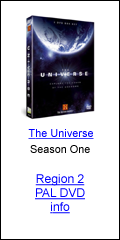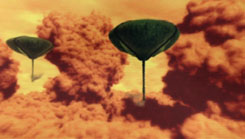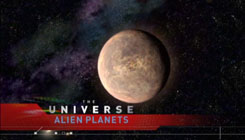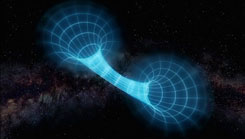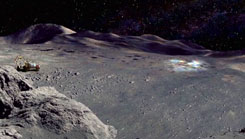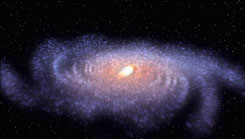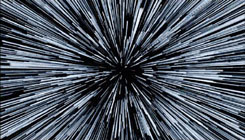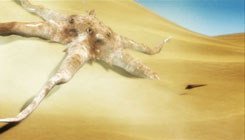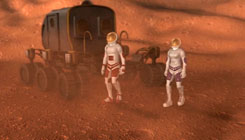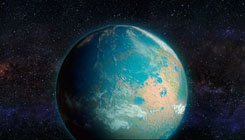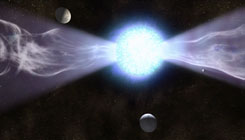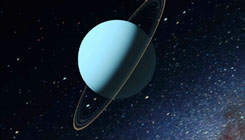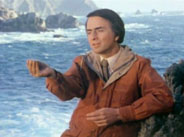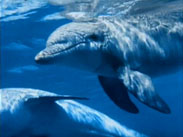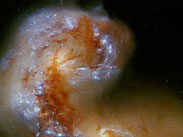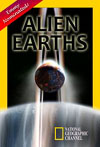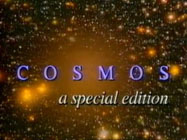"The Universe" Episode Guide Catalogue
|
|
|||||||||||||
| Episodes: | |||||||||||||
|---|---|---|---|---|---|---|---|---|---|---|---|---|---|
| 1 |
This episode examines the composition of the sun and its life cycle. Highlights include the theories behind its energy production, the complex magnetic "weather" patterns giving rise to its solar flares and sunspot activity, and the chance of a repeat of the huge solar storm of 1859. |
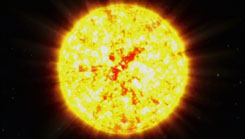
|

|
Chapter List:
|
|||||||||
| 2 |
As our most kindred planet in the solar system, Mars has been the focal point for much of Mankind's imagination about life in the universe and our own colonization of space. This episode does an excellent and fascinating job of covering our history of sending probes to Mars, from the Mariner missions of 1964 and 1971, to the Viking Missions, up to the present day mobile rovers. Surface features such as Olympus Mons: the largest volcano in the solar system, and its three companion volcanoes are examined, along with Mariner Canyon and some ideas for how it may have formed. Of course, the details of the search for evidence of some type of past life on Mars are at the heart of most segments. |
 |
Chapter List:
|
||||||||||
| 3 |
This becomes the first of many episodes that "The Universe" devotes to catastrophic scenarios. In fact, this episode acts as a teaser on so many subjects that it can't really go into great depth on any of them. Up first are the usual killer asteroid or comet impact events (Apophis 2029, Tunguska 1908, Chicxulub 65,000,000 B.C.) - but for a more detailed and interesting examination see season 3's "Stopping Armageddon" episode. Gamma ray bursts are introduced, but are covered much better in the season 4 opener "Death Stars". The fatal roast as the Sun blossoms into a red giant gets better depth and a much more optimistic spin in the season five finale "Dark Future of the Sun", also written and directed by Verklan. The theory of "The Big Rip", even though presented in this episode by the scientists who came up with it, isn't very convincing here in words or in CGI visuals. This theory has much more weight in the season two finale "Cosmic Apocalypse", where it can be better appreciated. |
 |
Chapter List:
|
||||||||||
| 4 |
by Amy Huggins & Andrew Nock Here we get a nicely focused episode all about the solar system's largest planet - the gas giant Jupiter. Many details of its composition, lack of a solid surface, weather patterns, and gravitational influence are explored. Though all of its four major moons are briefly introduced, Europa steals the show as we check in with a team designing, building, and testing a robotic explorer to penetrate its icy surface crust and explore the ocean below, looking for signs of life. Finally, we celebrate the majesty of Jupiter's magnetic field, as it creates polar aurorae and mysterious semi-musical radio waves. |
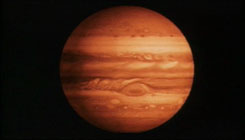
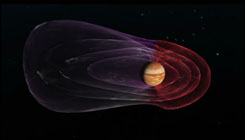
|
 |
Chapter List:
|
|||||||||
| 5 |
This episode covers many historical ideas of how the moon has affected our cultures and our environment, and how many different concepts about what it was and how it formed fell into and out of favour over the years. Many of these are visualized, and the problems with them are highlighted, while we learn a lot about the moon's general properties in the process. Finally, manned exploration brings back solid evidence of its composition, and planetary scientist Dr. William Hartmann is on hand to promote the Theia Impact Theory of lunar creation that he came up with, which is said to dominate scientific circles today. |
 |
Chapter List:
|
||||||||||
| 6 |
This documentary presents currently accepted theories of how the Earth was created during the formation of the solar system, including a very brief re-cap of the previous episode's critical Theia Impact event. This episode's true highlight is the expanded section on how life might have begun here, as we look at thermophiles, extremophiles, and cyanobacteria, as well as the unique conditions and extended time period during which they dominated the Earth. The episode is less focused in its final segments on climate change, yet contains interesting balancing comments when looking at the "big picture" of the Earth's entire lifespan. |
 |
Chapter List:
|
||||||||||
| 7 |
additional writing by Jason Coffee directed by executive producer Louis C. Tarantino Venus is up first, and we get all the nasty details of its scorched, hostile environment, with a particular focus on volcanic erosion, sideways lightning, and runaway greenhouse effects. Mercury takes over for the second half, and we discover a world geologically burnt-out at an early stage, which has been pummelled with space debris ever since. The limitations of the Mariner 10 survey of 1974 are made apparent, as newer data from the Messenger probe is anticipated.... |
 |
Chapter List:
|
||||||||||
| 8 |
This is a fairly definitive exploration of the planet Saturn and its most interesting moons and features. The nature of the planet itself as a fairly light-weight puff-ball continues with a discussion of its complex weather patterns, including some very unique polar storms. The composition of its distinctive ring system is up next, along with contrasting theories of the rings' creation and the question of how permanent a structure they may be. Saturn's moons Titan and Enceladus receive good coverage in the second half, and the episode ends on a brief celebration of the ongoing Cassini probe mission that has discovered so many of the details presented here. |
 |
Chapter List:
|
||||||||||
| 9 |
additional writing by Andrew Holland This episode presents many gorgeous images from Hubble and many other space telescopes, as it discusses how our galaxy compares to the others that have been sighted. The Andromeda Galaxy is highlighted, and its trajectory towards our Milky Way is contrasted with the increasing separation between all other galaxies. Also discussed is the Local Group, and we learn about a few of our nearest galactic neighbours. One of the episode's highlights is the speculation about what the universe was like before the first galaxies had formed. |
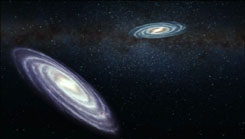

|
 |
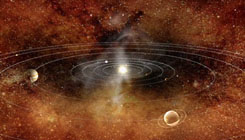 Chapter List:
Chapter List:
|
|||||||||
| 10 |
directed by Douglas J. Cohen This episode is Stellar Astrophysics 101 - a documentary that explores the concept of nuclear fusion, in terms of the mass requirements, gravitational conditions, and chemical ingredients necessary to make it happen to create a star. There is a lot of detail here on how different masses and chemistries produce different types of stars with very different lifespans, how different elements are fused and created during different phases of a star's life, and how the processes can eventually shut down and explosively transform into the next generation of stellar activity. Also introduced are brown dwarfs - a type of object not quite a planet nor a star, which had the right ingredients but couldn't quite ignite the fusion reaction. |
 |
Chapter List:
|
||||||||||
| 11 |
additional writing by producer Brittany Graham This episode covers many of the outermost worlds of our solar system, which have yet to be explored in great depth by man. A lot of satisfying details about Pluto are covered early on. As we dig into the controversy surrounding its demotion, we meet the man who discovered the very similar Kuiper Belt object Eris in 2005, and a lot of its details are similarly covered. We also get footage of the IAU voting to create the class of "Dwarf Planets", which now includes Pluto, Eris, and former king asteroid Ceres. The episode spends its second half exploring the outer gas giants Uranus and Neptune and their unique features, including the rings of Uranus, and Neptune's storm patterns and its moon Triton. |
 |
Chapter List:
|
||||||||||
| 12 |
After a quick study of magnetars and black holes, we meet the woman who proved that there is a supermassive black hole at the center of our galaxy, and she demonstrates the atmospheric adaptive optics process that allowed the necessary observations to be ground based. From there, we move on to the long-term certainties of galactic collisions, and how these can feed the central black holes sufficiently to produce brilliant quasars and blazars. |
 |
Chapter List:
|
||||||||||
| 13 |
|
 |
Chapter List:
|
||||||||||
| 14 |
directed by Luke Ellis Created by a completely different production company, this odd one-shot double-length documentary tackles many of the same history-of-astronomy-and-science basics as Carl Sagan's "Cosmos" although with many more interviewees and considerably less detail. Through it all, the role of the Earth becomes further decentralized, dwarfed first by the sun, then the galaxy, then finally the universe. But after tackling Einstein near the midpoint, the episode's true purpose and uniqueness come into focus, and we learn about many of the people and disciplines and theories and data that came together to champion the idea that there was indeed a big bang that created the universe, billions of years ago. Interviewees include some of the people that brought that theory into the light. |
 |
Chapter List:
|
||||||||||
| |||||||||||||
|
|||||||||||||
| 15 |
A short history of the search for extrasolar planets, from laughing stock obscurity
to fascinating leading edge of hard science. The episode details many of
the earliest exoplanets found, plus their orbital conditions and climate.
|
|

|
Chapter List:
|
|||||||||
| 16 |
This episode drills into the science behind black holes, white holes,
and wormholes. How likely are they to exist? Can they be used as
shortcuts or passageways? What are their implications to time/space/choice
mechanics? What is their relationship to the Einstein-Rosen Bridge?
|
|

|
Chapter List:
|
|||||||||
| 17 |
additional writing by Andrew Holland
This episode makes a very cautious presentation of Lunar Transient Phenomena (LTP's),
and delivers good info on tides and the Bay of Fundy, and the moon's orbital drift.
The episode does not entertain the mystery of the moon's origin, assuming
it formed in orbit of Earth instead of being captured later on, and
failed to argue its case convincingly or otherwise. The utter low-point is
the "COPS"-style search for the full moon to have unique gravitational effects
on elements of city crime.
|
|

|
Chapter List:
|
|||||||||
| 18 |
additional writing by producer Brittany Graham (no on-screen director credit)
A fascinating look at the geography of our galaxy, how we are hindered at
seeing it properly or directly, and the history of the methods employed to
learn about it. Other highlights include
the Sagittarius A object, the star Mira, and
the Milky Way's own galactic collisions in past, present, and future.
|
|

|
Chapter List:
|
|||||||||
| 19 |
directed by Louis C. Tarantino
This episode focuses on
|
|

|
Chapter List:
|
|||||||||
| 20 |
directed by Douglas J. Cohen
As interesting as the subject matter is,
the episode fails to convincingly communicate
how and why scientists are so sure that the theoretical estimated mass exerting
a distant galaxy's gravitational pull
is so much greater than the theoretical estimated mass of what they can see,
such that there must be some invisible dark matter that no one can comprehend
making up the difference. For a species that has traveled so little in the universe,
we assume a lot based on very little.
I would not be surprised if dark matter and dark energy theories one day
turn out to be an embarrassing dead end in science, abandoned for more
sensible theories.
|

|
Chapter List:
|
||||||||||
| 21 |
How does life first originate? Astrobiologists are exploring this question
here on Earth, in the ancient fossil records of Australia, in snowpack areas,
and in hot mud geysers, in order to predict the possibilities of life
on Mars, Titan, Europa, and unspecified exoplanets beyond.
|
|

|
Chapter List:
|
|||||||||
| 22 |
This episode explores the hazards and challenges of space travel,
calculates the time for various interplanetary trajectories,
and speculates on various new propulsion and flight systems
that might make current journeys quicker and make longer journeys possible.
|

|
Chapter List:
|
||||||||||
| 23 |
This investigation of Supernovas and our history of observing them
peaks as it details how type 1A supernovas became the "standard candle"
of astronomical measurements. Will you buy this theory? If not,
so many of the greater theories of the cosmos come crashing down as well.
|

|
Chapter List:
|
||||||||||
| 24 |
directed by Louis C. Tarantino
This episode gives a history of constellations in our culture, and
discusses their continuing importance to science, as well as many
fascinating specific objects in the heavens. However, it fails to
discuss the critical leap from looking at constellations as
connect-the-dot figures to the more scientific view of constellations
as directional areas with sharply defined borders.
|

|
Chapter List:
|
||||||||||
| 25 |
This one is like a collection of mini-episodes covering the five topics named in
the chapter list to the right. Is there a "Nemesis" brown dwarf orbiting our solar system
that can create extinction events like clockwork? One Time Travel / Black Hole researcher
hopes to save his father's life in the past, but after acknowledging
Level 3 alternate universes,
can he ever do more than visit his father's doubles? Also, meet a Mars researcher and his
robotic probes whose mission is to "follow the water", underground if necessary.
Where is the universe's anti-matter? And can we ever know what came before the Big Bang?
|

|
Chapter List:
|
||||||||||
| 26 |
The episode studies the forensic evidence of impacts in the
Kuiper Belt and the
|

|
Chapter List:
|
||||||||||
| 27 |
Should we give the green light to visiting and colonizing Mars now
with current technology, as advocated by the Mars Society, or should
we develop better technologies first and/or schedule more test trips
to the moon? This episode contrasts and details many aspects
of Mankind's plans for Mars.....
|
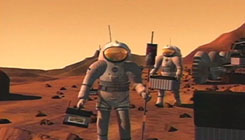
|

|
Chapter List:
|
|||||||||
| 28 |
This is a fascinating celebration of some of the most beautiful objects
in the sky. Science intersects with art, as methods of taking images of
nebulas are enhanced to reveal more information and look even more breathtaking.
Actual images from dozens of nebulas and meticulously researched 3D extrapolations
are presented, making this one of the most visually spectacular episodes
in the series.
|
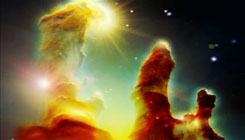
|

|
Chapter List:
|
|||||||||
| 29 |
directed by Douglas J. Cohen This episode presents a top 3 countdown in each of these categories: Wildest Winds, Wildest Tornados, Strange Rains, and Biggest Storms. Winners subsequently detailed include the south pole double vortex on Venus, various great spots on gas planets, and conditions on Hot Jupiter exoplanets and brown dwarf pseudo-stars.
|

|
Chapter List:
|
||||||||||
| 30 |
A valiant attempt to wrap our minds around the sheer scale of space objects
and distances results in a bit of competition to find the biggest examples
of many different types of object. These include the curious favourite of
Lymann Alpha Blobs, plus the largest exoplanet found so far, and finally
the dominance of Ceres over the rest of the asteroid belt.
|

|
Chapter List:
|
||||||||||
| 31 |
Join Alex Filippenko and Michelle Thaller
as they enjoy some fairground rides while talking about how
Newton figured out what gravity does, while Einstein worked out why it was doing it.
Gravity's math is sloppily presented, such that
formulae that only work in specific contexts are presented as
universal generalizations instead.
Centrifugal force is the only form of artificial gravity proposed in the episode
to promote human health on space journeys, with no mention of how a craft can maintain its
orientation with such a device in use.
|

|
Chapter List:
|
||||||||||
| 32 |
directed by Douglas J. Cohen (c) 2008 This episode explores the far future of the universe with depth and detail. Will the universe end with a fiery Big Crunch, and if so, is it cyclical? Can the life of the universe still be cyclical if it ends with the Big Freeze or Big Rip theories? The depth of time and the evolving state of stars, galaxies, and matter are illustrated expertly by the usual scientists of the program. |

|
Chapter List:
|
||||||||||
| -- |
This bonus feature is practically another episode of the show, and a high ranking
one at that, except that there is a new (uncredited) narrator, and no scientist interviews.
What it does particularly well is to highlight many of the easiest-to-view objects
and point out where to find them in the sky. Knowing when to view them is a bit arbitrary,
as many of the circumpolar objects that are visible all year round are distributed
amongst the 12 monthly segments such that all segments come to the same length.... and it
also seems to assume a northern hemisphere location that can still see significant portions
of the south. Still, this is a very nice feature. Programmed chapter stops also
make it fairly easy to skip ahead to any segment of interest for reference.
|
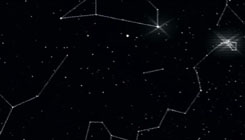
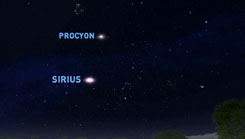
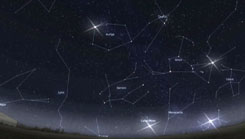
|

|
Chapter List:
| |||||||||
| |||||||||||||
|
|||||||||||||
| 33 |
After a ridiculous start, this episode soon settles down to recount problems,
challenges, and near disasters that astronauts have faced in the past, and moving
into the future, how scientists play Devil's Advocate to predict and pre-solve problems
that may occur on future space travel or colonization efforts on the moon or Mars.
Since the discussion spends most of its time either in Earth orbit or on Mars,
the "deep" part of the title feels highly gratuitous.
|
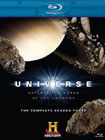
|
Chapter List:
|
||||||||||
| 34 |
by Andy Papadopoulos
This episode takes its time to go over the "4 levels" of alternate universe types,
along the way detailing the shape of our universe as discovered by the WMAP probe,
11D String-theory and M-theory's application in spawning new bubble universes,
the quantum physics behind alternate history universes, and the random physics
of fourth level universes.
|
|

|
Chapter List:
|
|||||||||
| 35 |
This documentary touches on a wide variety of phenomena all related
to the speed of light, from looking farther into the past the further
we gaze in space, to time delays in communicating with astronauts and
unmanned probes throughout our solar system, to various illusions
of bending light and warping time. Nicely, it teases us with presentations
of scientists who slow light down and research faster-than-light travel,
but sadly the details there are limited, and once again the case
for the common claims about Einstein's theory of relativity
remains unconvincing in this presentation.
|
|

|
Chapter List:
|
|||||||||
| 36 |
directed by executive producer Louis C. Tarantino This oft-ridiculed entry spends most of its time on micro-gravity's effects on the development and functioning of mammals from conception to adulthood. Not bad, but there's silly stuff here as well, and the episode doesn't quite rise above the sensationalism that many of its interviewees feel is unhealthy for the subject matter. (c) 2008 |

|
Chapter List:
|
||||||||||
| 37 |
In order to wrap our minds around the kinds of life
that might exist in the very different environments of
extrasolar worlds - so we'll know what to look for and recognize it
when we see it, astrobiologists have extrapolated from known science
to create some very detailed models of a variety of lifeforms
and alien ecosystems which are recounted
and brought to life in this episode.
|
|

|
Chapter List:
|
|||||||||
| 38 |
This is the one where Amy Mainzer whips up a comet from scratch in a bowl in the lab.
She can cook! This episode contrasts asteroids from the
Maldek belt with comets from the Kuiper belt / Oort cloud,
and examines their composition. Which is more likely to have seeded the Earth
with water and building blocks for life? Highlights include discoveries made
from the drilling project at the dinosaur-extincting impact site on the Yucatan peninsula,
plus the computer simulation comparison of the Shoemaker-Levy 9 impacts on Jupiter with
the Tunguska impact in Russia.
|

|
Chapter List:
|
||||||||||
| 39 |
directed by Annie Azzariti
This documentary looks at the challenges of living, eating, and driving around on Mars,
in a theoretical 23rd century colony. Experiments sealing a group of humans into
a self-contained bio-dome environment are reported, where small oversights caused
big problems. Many all-terrain vehicles designed for extreme environments and
other planets are showcased, along with more flexible streamlined spacesuits.
We take a look at how Martian colonists could grow their own food, and what their
diet might be like. Finally, our investigations escalate towards the practicality
of mining the asteroid belt for all of the industrial needs on Mars.
|
|

|
Chapter List:
|
|||||||||
| 40 |
This is a very thorough look at our ability to detect asteroids and other objects
that could potentially impact Earth, how much lead time we would have,
and what we might be able to do to deflect them. Much better than the
previous "Deadly Comets and Meteors" episode.
|

|
Chapter List:
|
||||||||||
| 41 |
The search for exoplanets combines with geology and biology theory to try to predict
where we might find a planet similar enough to our own to produce not only life, but a kindred civilization.
|
|

|
Chapter List:
|
|||||||||
| 42 |
Several of the series' regular scientific contributors recount the
strangest astronomical phenomena and weirdest concepts they've encountered,
resulting in a smorgasbord of interesting topics,
from the moon Miranda, to the asteroid Toutatis,
to planets, stars, galaxies, tiny particles, and concepts of theoretical physics.
Definitely one of the most fascinating episodes of the series.
|
|

|
Chapter List:
|
|||||||||
| 43 |
directed by executive producer Louis C. Tarantino
For clarification, this episode's title refers to the starter's edge bordering on Earth atmosphere,
not the far frontier of intergalactic void. There is a lot of interesting data here on
the various levels of Earth orbit, and which orbits are inhabited by various satellites &
collections of space debris. The section on the complex tracking of thousands of
pieces of debris and space junk is one of the most eye-opening segments in the
entire third season. Also covered are many different plans for sending people into
orbit commercially, and the various commercial enterprises that have already put
people and spacecraft into space.
|

|
Chapter List:
is titled Kepler Mission, since this is not discussed here at all.... |
||||||||||
| 44 |
A more apt title might have been "Atmospheric Phenomena with Cosmic Causes",
because pretty much everything explored in this episode has an interaction
with our atmosphere, or with life on Earth. Some of its better portions discuss
auroras, "shooting star" meteors, and the relatively newly discovered phenomena of
electrical discharge sprites, plus the transient luminous patches known as elves.
Interestingly, the section on ultraviolet radiation and its effects on skin
bring out a lot of helpful, true information on the subject, yet don't quite
make the leap of awareness of the importance to have unsaturated fats present
in the skin to turn potentially harmful rays into Vitamin D producing rays that
can power the body up. See 7-time Nobel Prize nominee
Dr. Johanna Budwig's book
for that.
- Season Three episode Rankings
|

|
Chapter List:
|
||||||||||
|
|||||||||||||
|
|||||||||||||
| 45 |
This episode demonstrates why gamma-ray bursts occur in directional beams from supernovas, and explores many objects that already have or may yet produce a burst. The scientists present excellent, fascinating details of objects like the dying star WR104 and its spiral nebula 8000 light years distant, the stars Eta Carinae and Betelgeuse, and the galaxy 3C321. Unfortunately the narration repeatedly hypes gamma ray bursts as if they were attacks, like a piece of propaganda. The second half of season four seems to curb this tendency from the writers much better than the first half. |

|
Chapter List:
|
||||||||||
| 46 |
directed by Rob Beemer In the scenario for the first segment, Earth gets to have its moon up until the present day, until it magically vanishes in an instant. The episode soon belongs to interviewed planetary scientist Dr. William K. Hartmann, whose Theia impact theory of the moon's creation is detailed in the second segment. The premise soon changes to speculate what the Earth would be like if it had never had the moon in the first place. The episode explores wild climate fluctuations, incredible winds, shorter days, darker nights, and the unsustainability of life forms as complex as human beings. The real highlights include the examination of the wildly fluctuating tilt of the axis of Mars, and the final question: Is the Earth actually scheduled to lose the moon sometime in the far future? |

|
Chapter List:
|
||||||||||
| 47 |
This episode details a 2008 asteroid that was spotted in space, tracked until it crashed in the Sudan in Africa, and collected as meteorite fragments. Also examined is the archaeological evidence of a theorized comet impact that may have extended the last ice age and wiped out many large mammal species in North America. Finally, we look at a meteorite impact on the Peru-Bolivia border, the largest collection of meteorites held by any university, and various pieces of man-made space junk that have crashed back to Earth. |

|
Chapter List:
|
||||||||||
| 48 |
This episode presents a top ten countdown of the biggest cosmic energy releases known to astronomers - with eleven "winners". Unique highlights include the Shoemaker-Levy 9 impacts on Jupiter in 1994, an ancient impact on Mars, two exoplanets in a system 300 LY away in Aries that may have had a head-on collision, and the MSA 735 black hole plumes that push entire galaxies apart within their cluster. These are compared to the usual suspects: supernova explosions, the Chicxulub asteroid impact on the Yucatan Peninsula that may have contributed to dinosaur extinction, and even the universe creating "Big Bang" itself. |

|
Chapter List:
|
||||||||||
| 49 |
directed by Douglas J. Cohen Since this episode pretty much stays within our own solar system, it's not so much a hunt for the planets as it is for the rings around them. Although spending the largest chunk of time on the most obvious rings known - around Saturn - it also examines the lesser celebrated rings detected around Uranus, Jupiter, and Neptune, the search for rings around Pluto, Mars, and transiting exoplanets, and how we humans have created a man made ring of satellites around our own Earth. |
|

|
Chapter List:
|
|||||||||
| 50 |
in about the same place, James Grant Goldin takes a "produced by" credit. science consultant Dr. Alex Filippenko directed by Louis C. Tarantino This is one of the silliest episodes of this show ever. While the science remains interesting, it often gets short-changed and overshadowed by the episode's drive to sensationalize destruction. Mention of several types of quarks and strange matter was a fascinating topic, sadly brushed aside to return to idle re-run sensationalism yet again. Many of the methods explored (swallowed by a mini-black hole, switching off gravity, etc.) are wildly speculative anyway, and most materialize on cue as though by magic. Not the most useful or interesting episode of the series, I think. Professor Zaroff of "The Underwater Menace" would have fit right in with the other interviewees. |

|
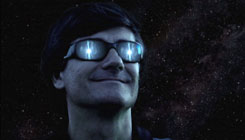
Chapter List:
|
||||||||||
| 51 |
Star Clusters contain stars of the same age formed from the same material. Using an imaginary spacecraft to travel the universe, this episode contrasts young open clusters in the spiral arms of our own galaxy with older globular clusters in the galaxy's outer edges. Highlights include the examinations of the nearby Pleiades star cluster, the very unusual orbit of M12 around the center of the Milky Way, and the complex calculations needed to simulate interactions of multiple large objects in dense groupings. Also examined are galactic clusters, and how they change and evolve over time, back to the big bang and forward as far as we can imagine. The scale of this episode blows the mind! |

|
Chapter List:
|
||||||||||
| 52 |
directed by Rob Beemer dedicated to the memory of season 3 writer Jason W. Coffee This episode is all about the details and effectiveness of various military ideas to create defences and weapons that operate in space, or against threats from space. The segment on lasers is fairly interesting. Beyond that, the subject isn't covered with much scientific depth, and certainly not with much wisdom. A recap of the far superior late season three episode "Edge of Space" might be a good reminder of why no one should want to create shrapnel and debris in orbit. |

|
Chapter List:
|
||||||||||
| 53 |
directed by Louis C. Tarantino This episode is all about the narrow range of temperature and pressure required to cause matter to remain in the elusive middle ground of a liquid form, how different planetary and celestial environments like Titan, Gliese 581 d, Jupiter, and brown dwarfs can cause this to happen to substances like iron, methane, and hydrogen, as well as water, and how these substances might behave differently in these environments. Also explained is the concept of "ice-7". |
|

|
Chapter List:
|
|||||||||
| 54 |
How does an object as tiny as a pulsar emit such a powerful magnetic field just from spinning so fast, and why does it appear to blink on and off? Learn about the discovery of the first pulsar, how it got its name, the incredible power and activities of the pulsar at the center of the Crab Nebula, and how pulsars like the Vela pulsar are inspiring musicians with their rhythms and choirs. Plus, "The Universe" finally spills the beans on how we detected the first pulsar planets in 1992. Then, what are the properties of quasars, and how did they get their name? Are they really remnant cores from older, expired galaxies? How are we detecting these incredibly distant quasars - possibly the oldest objects in the universe? |

|
Chapter List:
|
||||||||||
| 55 |
Regular Alex Filippenko is joined by sci-fi writer/consultants Andre Bormanis and Kevin Grazier to critique the science behind many sci-fi films and TV shows. The Star Trek franchise and its 11th film by J.J. Abrams go under the microscope, along with Back to the Future, War of the Worlds, Independence Day, and Armageddon. Not sure why they fixate on atomic reassembly to make beaming-up possible... I'd aim for interdimensional portal technology for personal teleportation myself. Highlights include a more realistic scenario of a black hole devouring the solar system, the flexibility of the Drake equation, and a look at how well science fiction of the past has predicted the present day. How close are we to achieving some of the advanced technologies imagined in science fiction? The scientific community may be paying more serious attention to these ideas than we might assume... |

|
Chapter List:
|
||||||||||
| 56 |
This episode examines the various energy exchanges and transformations occurring all throughout the universe, and how well it all balances out according to the law of conservation of energy, from black holes ejecting powerful jets, to the steady nuclear burn of regular stars.... Highlights include the exploration of geothermal energy on Io and Earth, the different processes generating it, and the difficulties in harnessing it for commercial use. |

|
Chapter List:
|
||||||||||
DVD Bonus Features
|
|||||||||||||
|
|||||||||||||
| 57 |
This is one of the most famous episodes of the series. Five regular scientific contributors to the show take viewers on a ride in a fictitious spacecraft around several highlights of our own solar system, including new photos & data of the ice geysers on Saturn's moon Enceladus from the Cassini spacecraft flyby of November 2009.
|
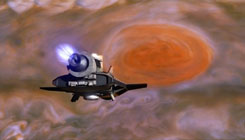
|

|
Chapters:
|
|||||||||
| 58 |
by James Grant Goldin The Phoenix probe became one of six studying the planet Mars when it landed in the north polar region in 2008. Find out what scientists learned from processing the wealth of data collected at this time, including the three possibilities behind new methane plumes on the surface, and supposedly impossible evidence of liquid water on the surface. How close were we to declaring bacterial life on Mars? -
more details
|

|
Chapters:
|
||||||||||
| 59 |
This episode puts its focus on what seems to be season five's favourite topic:
Coronal Mass Ejections from the sun, and of course their possible devastating effects
on the infrastructures of our electrical civilization on Earth (which it repeats too often
for my taste). The real highlights
concern magnetism as a basic force, and the magnetospheres of the sun and each planet
of our solar system - how they are generated, how strong they are, and what may have
happened to some of them, and how Earth's magnetic poles have reversed several times
in past history.
|

|
Chapters:
|
||||||||||
| 60 |
An excellent episode, perhaps limited in its view of theoretical time travel physics, but making up for it by combining that with other theories creatively, exploring the paradoxes and their elegant solutions. We also spend significant time looking at experimental implications from the Large Hadron Collider in Switzerland.
One of the biggest highlights
is an unexpected segment exploring everything known at that
point about Alpha Centauri's possible exoplanets along with the
feasibility of a very nicely visualized round-trip mission.
|
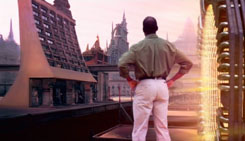
|

|
Chapters:
|
|||||||||
| 61 |
This episode is devoted to the workhorses of space exploration:
the planetary surveyors, space telescopes, and phenomenon-chasing
probes that gather the information and samples that scientists use
to make their discoveries. The episode
covers the history of our probes, the difficulties in aiming them,
launching them, and sustaining them, and what many of their discoveries were...
|
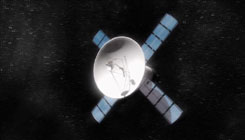
|

|
Chapters:
|
|||||||||
| 62 |
This episode hits paydirt when simply furthering our exploration of asteroids.
Highlights include the recounting of past and current missions to asteroid belt objects
such as the 2001 Near mission to Eros, the Hayabusa asteroid sample-extracting mission,
and the 2007-launched Dawn mission to Vesta (arrival 2011) and Ceres (arrival 2015).
The episode also excels when digging into the composition and orbits of asteroids, or indeed
comparing various impacts on Jupiter, and how many asteroids of each size-type we've discovered
so far versus how much we think is out there.
Sadly, there's about 10 minutes worth of screen time wasted on motivating and obscuring
the research with the old re-run "It could hit the Earth!" framing idea,
repeating impact footage from this episode and previous ones over and over
and over. The good bits make the episode
worth watching, but it ranks the lowest of all asteroid-impact episodes yet
in "The Universe".
|

|
Chapters:
|
||||||||||
| 63 |
This episode explores solar eclipses, lunar eclipses,
other planet/moon shadows in our solar system, and
extends to cover the transit technique used in detecting
extrasolar planets. The last segment marks a milestone,
as it is the first time in the series to feature
hot-off-the-press results from
the exoplanet-hunting Kepler Mission.
|
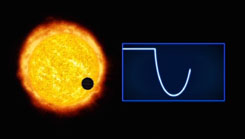
|

|
Chapters:
|
|||||||||
| 64 |
This is the one where Alex Filippenko goes cruising in a white sports car
and compares the varied states of his fuel tank to the sun's energies during
the various stages of its life span. Highlights include ideas for changing
the Earth's orbit to survive the red giant phase, and climatic changes on Mars
and other planets during the various phases, plus a look at exoplanets that survived
drastic phases of their suns Chi Cygni (reported here to be 50 LY away) and 391 Pegasi.
|

|
Chapters:
|
||||||||||
|
|||||||||||||
|
|||||||||||||
| 65 |
written and directed by Laura Verklan
This episode presents a countdown of ten events that impacted the other planets
of our solar system, and manages to have a fresh take even on those that were mentioned
in previous episodes. Every major planet is involved somewhere, and not all events
are impacts. Disappointingly, each of the impacts is an individual story, often with
unknown objects coming in out of nowhere to hit our familiar neighbours,
and we don't connect the dots to imagine our solar system with more planets
in different configurations at earlier stages. No one yet dares to tackle the theory
of Maldek breaking apart to form the asteroid belt. However, it seems the more we learn
about our solar system, the less it resembles an orderly set of 8 fairly stable, almost
circular orbits. Though the scientists give a lot of good information, the narration
is stuck in "threat-mentality" much too often for its own good, and more so than
most other episodes of this season.
|
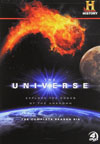
|
Original Air Date: 2011 October 25 Chapters:
|
||||||||||
| 66 |
written by Savas Georgalis
In addition to the usual gang, Richard Muller is on hand to explain his theory of an undiscovered dark red dwarf star orbiting our sun elliptically in a 26-million-year cycle, which might explain a perceived regularity of extinction-by-comet events in Earth's history. Might new infrared sky surveys by the WISE satellite finally reveal this object? The fourth of the episode's five segments is actually the most interesting, as observed comet patterns indicate the existence of a much smaller object called "Tyche", a planet 4 times the mass of Jupiter orbiting the outer reaches of the solar system. Mike Brown is also on hand to take us through his 2003 discovery of the dwarf planet Sedna, and to show us what this object's bizarre orbit can tell us about the possibility of other big undiscovered objects so far out. (c) 2011 |

|
Original Air Date: 2011 November 1 Chapters:
|
||||||||||
| 67 |
written and directed by Darryl Rehr
Though many of the ideas in this episode have been presented before,
this documentary is unique in bringing it all together and presenting
it chronologically and coherently, charted along a timeline of the
first 700 million years of our 4.6 billion year old solar system.
This is definitely the best documentary to tackle the subject I have ever seen.
Though it is mentioned that our sun had brothers and sisters born at the same time,
the documentary misses out on our being part of a Sirius trinary system,
as well as the idea of a fifth planet that broke up to form the asteroid belt.
Excellent points include the concept of Uranus and Neptune swapping positions,
and how gravitational slingshotting affects the large planets when they do a lot of
it over time. Near the end, we also get some tantalizing glimpses of other
solar systems discovered by the Kepler space telescope.
|

|
Original Air Date: 2011 November 8 Chapters:
|
||||||||||
| 68 |
written and directed by James Grant Goldin
This episode explores the challenges and contingencies of an early pioneer landing on Mars
in a scenario where the habitat module and crew crash land off course, many miles
from the Earth-Return Vehicle meant to bring them back home. Live-action actors re-enact
most of the story beats that the scientists envision, a noticeable improvement over the
CGI-only figures of past episodes, as this crew clambers into its surface rover to
drive through Mariner Valley to their new destination. Along this adventure, we learn
much about Martian surface atmospheric conditions, and how we and our technology might
best interact with it.
|

|
Original Air Date: 2011 November 22 Chapters:
|
||||||||||
| 69 |
written and directed by Laura Verklan
This is a much better episode than its awful title or disastrous framing could suggest,
as it contains a 40-minute core history of how the evolving Earth supported different
kinds of life at various points, and what happened to change the Earth and the variety
of life it was nurturing. Even obvious events that have attained legendary re-run status
in the series by this point such as the Chicxulub dinosaur extinction are filled with
controversial new theory and possibilities, while the earlier bombardment phases do justice
to describing the very different environment of Earth at those times. Highlights include
exploration of the mega-ice-age Snowball Earth periods, and discussion of the solar system's
position in its galactic orbit during some of these events. It's just too bad
we have to hold our noses at their ridiculously vain attempts to entice us
by citing threat and disaster as each segment opens or closes.
|

|
Original Air Date: 2011 November 29 Chapters:
|
||||||||||
| 70 |
written and directed by James Hense
This documentary spends most of its time discussing interstellar spacecraft design
and propulsion systems, believe it or not, featuring some awesome actual test
footage of the Orion system proposed in the 1960's. Only the first segment
is really centered on the Unidentified Flying Object phenomenon, during which
we get some nice details about important firsts in our culture surrounding
some of the ideas. The last segment in particular feels like an odd left turn
into some re-run territory that is really not impressive in what it presents.
Though not too bad an episode, it perhaps could have found greater cohesion
with a different title, with narration framed under a different topic.
Did we really need to reverse-engineer theoretical extra-terrestrial craft
in order to believe in UFO's enough to investigate actual reports?
|

|
Original Air Date: 2011 December 13 Chapters:
|
||||||||||
| 71 |
written and produced by Daniel Snyder
Most of the conflict in debates for or against God usually arises out of differences
in how the terminology is defined,
and that certainly appears to be the case in the first few segments of this episode
as many re-run creation-of-the-universe concepts from earlier episodes are repeated,
and then thrown at the God question. The episode's biggest highlight is presented by
Leonard Mlodinow who, along with Stephen Hawking, came up with the "No Boundary Proposal"
in their book "The Grand Design" - a fascinating all new idea of what is at the
"beginning" of the universe, worthy of further examination and its screentime here.
Some nice big concepts are tackled late in the show,
with all due auras of grandness, yet the futility of making a debate out of the central
question seems a bit old and tired.
|

|
Original Air Date: 2011 December 20 Chapters:
|
||||||||||
| 72 |
written and produced by Savas Georgalis
This episode's focus is to create human-scaled metaphors to make large astronomical
measurements more easily understandable.
The size/distance examples in segments two and three work fairly well,
which feature a yellow bowling ball representing our sun, and then compared
to larger stars and smaller planets, with our solar system spaced out on an airstrip runway.
The first segment's mass/gravity metaphors aren't so good... but stay tuned for the better bits.
The final segment is good again, visualizing the distance of grain-of-sand-sized Alpha Centauri
from the Griffith Observatory, and the distances between galaxies.
|

|
Original Air Date: 2012 April 29 Note the huge gap in the air dates between this episode and the last. A mid-season break, or the start of a whole new season? Opinions differ wildly.... Chapters:
|
||||||||||
| 73 |
written and directed by Darryl Rehr
After an introductory section to explain the various ways that sound
can be transmitted through space and the atmospheres of alien worlds,
this episode proceeds through a top ten countdown of alien hits...
as selected by astronomers. The sounds are increasingly more complex
and interesting as the documentary goes on.
Sounds you might expect to return from previous episodes
crop up fairly early on, while later segments feature all new stuff,
and only one of the ten slots is used to cover the entire spectrum of pulsars,
with many excellent examples heard. Highlights include some very detailed
examinations of Ganymede and many other outer moons of the solar system,
as well as the spacecraft probes that explored them and "listened in".
|

|
Original Air Date: 2012 May 6 Chapters:
|
||||||||||
| 74 |
written and directed by James Grant Goldin Where is our solar system in relation to the spiral arms of our galaxy? Learn more about the objects that are closest to us in the galactic neighbourhood - the orange dwarf Gliese 710 coming towards us, the brown dwarf at a cool 80 degrees Fahrenheit, Epsilon Eridani, the exoplanet Kepler 16b, the "homeless" planets, the supernova candidate HR 8210.... and find out why we might just be in the most perfect place in the galactic habitable zone.... -
more details
|

|
Original Air Date: 2012 May 13 Chapters:
|
||||||||||
| 75 |
written and directed by Colin Campbell
This episode examines the flow of energy from hot to cold,
beginning with the high temperatures of the big bang and
finishing with the theorized end of the universe in a deep freeze.
Along the way, many of the coldest places we know of are examined,
from brown dwarfs cool enough to touch, to the dwarf planets Pluto and Sedna,
to exoplanets orbiting other stars and rogue planets cast loose into interstellar space.
The episode also looks at ecosystems that can survive extreme cold on many
of these places, including Europa, Enceladus, and some wildly extreme conditions
on Earth.
|
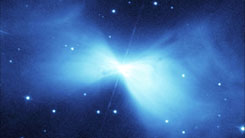
|

|
Original Air Date: 2012 May 20 Chapters:
|
|||||||||
| 76 |
written and produced by Daniel Snyder
The focus of this episode is actually much smaller than microscopic -
it goes down to the quantum level, and asks questions to try to get a handle
on the remarkably different style of physics at work at this scale.
We actually see a quantum computer and its operators, although the show
remains vague on exactly what it is about this machine that makes it different.
The double-slit experiment was perhaps better demonstrated in
"What the Bleep Do We Know?", but this episode
goes a step further in offering some more recent variations and theories about it.
Clifford Johnson's game of billiards is re-visualized as though it was taking place
on the quantum level. Later sections go into more detail concerning the fundamental
structure of the universe. Despite some sections not going into enough detail to satisfy,
this one still managed to be quite a mind-bender and mind-blower.
|

|
Original Air Date: 2012 June 3 Chapters:
|
||||||||||
| 77 |
written and directed by Laura Verklan
This episode completes the obvious in its first segment: taking the show's
imaginary spacecraft to the Oort cloud, figuring out which comets out there
are good to land on and which not, and following one of them through its
entire orbit around the sun. A lot of specific comets are studied during the
remainder of the episode, with recaps of the various probes making observations,
and the unique things we've learned from each encounter. Even with repeat information
poking through here and there, this is one of the most complete documentaries ever
on the subject of comets.
|

|
Original Air Date: 2012 June 10 Chapters:
|
||||||||||
| 78 |
written and directed by James Hense
The theme of this episode is the search for evidence of astronomical events that have influenced the last 15 thousand years of Human history here on Earth. Sadly the idea's proponents can only think of one type of astronomical event - an asteroid and/or comet hitting the Earth. Since this has been done to death on "The Universe" by this point, it results in a fairly dull episode. The first two historical periods affected, taking up the first 60% of the episode, are fairly well-documented by the Holocene Impact Working Group, and did present a lot of new information. Too bad theories of our solar system's past involvement with Sirius don't get run by our scientists, to give the show some variety. Later, we get a re-run of a North American extinction theory which doesn't seem to have anything new in it. The documentary is really reaching later on, when it pushes to give a comet credit for making Emperor Constantine decide that the Roman Empire would switch to Christianity in 312 A.D. Surely the Emperor must have seen something convincing in the religion before he saw anything in the sky, or the religion would not have been his first thought....
|

|
Original Air Date: 2012 June 17 Chapters:
|
||||||||||
|
|||||||||||||
| 79 |
written and directed by Darryl Rehr This episode goes in depth to reveal the structure of Stonehenge today as well as what it must have been like just after completion. Detailed computer simulation allows scientists to browse through sunrise, sunset, moonrise, and moonset as would be observed at Stonehenge on any day in any year... which leads to some interesting speculation on what the monument was for.... Many details of the moon's 18 year cycle and other cycles are recounted and reviewed in the process. |
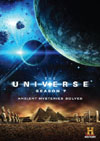
|
Original Air Date: 2014 March 1 |
||||||||||
| 80 |
written and directed by Laura Verklan This episode investigates the structure and alignments of the three great pyramids at Giza, Egypt, along with the nearby Sphinx. Astronomical topics roped in include discussions of the north star changing over time (with additional detail concerning Precession), the belt stars of Orion, and the path of the sun. The narration struggles to connect Egyptian mythology to any of this in an interesting fashion though... |

|
Original Air Date: 2014 March 8 |
||||||||||
| 81 |
written and directed by Laura Verklan Here the disciples of TV astrophysics return to worship the almighty asteroid impact, bringing the usual offerings of loud CGI explosions and randomization statistics that we've seen countless times before. Yawn. The attempt to make this fresh by attaching it to the destruction of the cities Sodom and Gomorrah described in the Bible is quite a load of both loose and limited thinking. Not explored in the episode is the obvious - that a high tech civilization nuked the cities on purpose, AND gave some individuals a warning in advance. Forensic evidence gathered in the episode easily supports this idea just as well as the asteroid theory that is kind-of shoehorned in instead.... only no one knows if any of the forensic evidence amassed so far is actually coming from the correct site(s). Ay caramba! This is far from an ancient mystery solved! The best bit may be the presentation of footage from the impact in the Russian city of Chelyabinsk on February 15, 2013.... which is actually new for "The Universe" when this episode was made... |

|
Original Air Date: 2014 March 15 |
||||||||||
| 82 |
written and directed by James Grant Goldin Ultimately, there is an interesting investigation into stellar and planetary phenomena here, including details of retrograde motion, conjunctions, and the difference between a nova and a supernova. Too bad all this good stuff gets lumbered with the star of Bethlehem question hanging around its neck again and again. It's pretty painful to watch scientists limit their thinking to large-scale purely mechanistic astronomical phenomena, and then systematically debunk each one from fitting the Star of Bethlehem story. Why couldn't this bright light in the sky be caused by a vehicle like a helicopter or extra-terrestrial craft - something containing the intelligence ingredient also in the story, and small and mobile enough to actually lead wise men to a specific spot on the ground? Are scientists too selective regarding which parts of the story they are willing to acknowledge? The examination of historical text has merit though in being interesting in and of itself, and in being thorough enough to explore variations in translation from the original language, as well as the circumstances of its authors. - Season Seven episode Rankings
|

|
Original Air Date: 2014 March 22 |
||||||||||
|
|||||||||||||
| 83 |
|
Original Air Date: 2015 April 18 |
|||||||||||
| 84 |
|
Original Air Date: 2015 April 25 |
|||||||||||
| 85 |
|
Original Air Date: 2015 May 2 |
|||||||||||
| 86 |
|
Original Air Date: 2015 May 9 |
|||||||||||
| 87 |
|
Original Air Date: 2015 May 16 |
|||||||||||
| 88 |
|
Original Air Date: 2015 May 23 |
|||||||||||
|
Cosmos 4: Heaven and Hell - Comets, Impacts, Venus Cosmos 13: Who Speaks for Earth? - Cultural Leadership and Wisdom The Universe 7: "Mercury & Venus: The Inner Planets" |
|
|
New for October 13, 2017:
|
||||||||
|
|

LYRATEK.COM |

LYRATEK.COM
|



